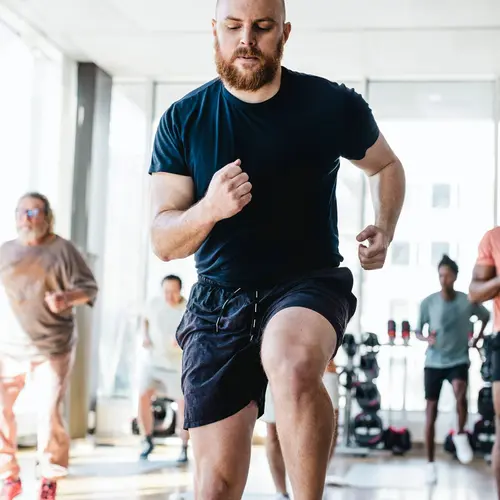What Is Plyometrics?
Plyometrics is a type of exercise training that uses speed and force of different movements to build muscle power. Plyometrics training can improve your physical performance and ability to do different activities.
Plyometrics can include different types of exercises, like pushups, throwing, running, jumping, and kicking. Athletes often use plyometrics as part of their training, but anyone can do these workouts. People who are in physical rehab after an accident or injury use plyometrics to get back into good shape and physical function.
If you’re in good shape and looking to ramp up your workout, you may enjoy the challenge of plyometrics. It's a great way to train if you’re into high-impact sports that involve a lot of running or jumping, like tennis, skiing, or basketball.
When you're getting started, work with an experienced trainer who can show you how to safely jump and land. Start slow and low. Mix a few plyometric moves into your regular workout.
Because plyometrics is high-impact and intense exercise, check with your doctor first if you aren't active now or if you have any health problems.
Plyometrics isn’t the workout for you if you don't like to sweat or are just looking to strengthen your core.
How Plyometrics Works
Remember the fun you had as a kid, hopping, skipping, and jumping around the playground? The exercises you do with plyometrics mimic those dynamic moves.
Plyometrics ("plyo," for short) used to be called "jump training." It's a technique you can use in many different ways. For instance, you can do plyometrics to help train for basketball, volleyball, tennis, or any other activity that uses explosive movements.
You'll do a series of jumps and hops, like jump squats or one-leg hops. You might jump up and onto a box or bench, or jump over cones. Some moves will be faster than others.
Every time you land from a jump, your muscles get a stretch. That gives your next jump even more power. The combination of stretching and contracting your muscles whips them into shape.
You won't do plyometrics every day, because your muscles will need a break from all that jumping. If you aren’t active now, you may need to start working on your basic fitness first and later have a pro show you how to do the moves, so you don't get injured.
It’s a fun alternative to an everyday strength training workout that boosts your muscle power, strength, balance, and agility. You can either do a workout based on plyometrics, or add some plyo moves to your usual routine without giving it an entire session.
Intensity of Plyometrics
This workout uses maximum power to strengthen your muscles. The moves are quick and explosive, so prepare to use a lot more energy than you do in a typical strength training session.
Areas Plyometrics Targets
Core: No. This workout doesn’t specifically target your core.
Arms: No. Most plyometric workouts don't target your arms. But if you want to work them, you can add upper-body moves, like medicine ball throws and plyometric pushups.
Legs: Yes. Expect your legs to get in great shape from all the jumping and hopping.
Glutes: Yes. Moves like jump squats fire up your glutes to make them stronger.
Back: No. Though the workout involves your whole body, it's not focused on your back muscles.
Plyometrics Workout Type
Flexibility: Yes. This workout is based on a combo of contracting your muscles and stretching them, which is great for flexibility.
Aerobic: No. It isn’t considered an aerobic workout, but if you repeat your jumps without pausing, for about 30-60 seconds at a time, your heart rate will go up.
Strength: Yes. This workout is all about boosting your muscle power.
Sport: No.
Low-impact: No. There’s a lot of high-impact jumping and hopping.
What Else Should I Know About Plyometrics?
Cost: Free.
Good for beginners? No. If you aren’t in great shape already, choose another workout before taking a stab at this one, which may cause injuries if you’re not used to moves like these.
Outdoors: Yes. It can be fun to bring this workout outdoors. Just be sure to choose a soft surface for landing, like grass.
At home: Yes. Just get an exercise mat. It’ll give you a safer, softer landing pad than a hard floor.
Equipment required? No. You can do this without equipment. Or you can use cones or foam barriers to jump over.
Plyometrics and Chronic Health Conditions
It's a good idea to check in with your doctor first, especially if you aren't active now or have health problems. They can let you know what's safe for you to do.
If you have heart disease, high blood pressure, or high cholesterol, the doctor may recommend a lower-intensity type of exercise that’s more aerobic.
If you have diabetes, you may need to make some changes to your diabetes treatment plan, based on how many calories you are burning. Plyometrics isn’t for you if you have any diabetes-related nerve damage, as this will make you more likely to get injured.
Do you have arthritis or other bone or joint problems? Plyometrics isn’t a good choice for you. Look for a workout that can help strengthen your muscles without stressing your joints.
Plyometrics isn’t for you if you’re pregnant. Your belly’s growing size will throw off your balance. You could fall or get injured. The weight of your growing baby stresses your knees and ankles, and jumping adds even more stress. Ligaments that help stabilize your joints grow a little more lax during pregnancy, making injuries more likely.
If you have any physical limitations, choose other strength-building exercises that will be safer for you.

